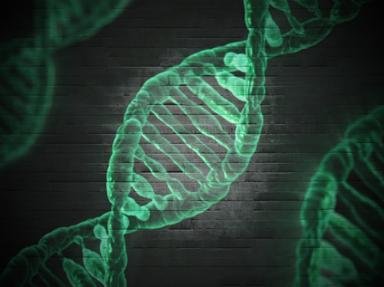Quiz Answer Key and Fun Facts
1. The basic mechanism of DNA replication was determined by the Meselson-Stahl experiment. In this experiment, they bred bacteria in nitrogen-15 (N-15) media for many generations, which had the effect of making the bacterial DNA denser than normal DNA (which consists mostly of nitrogen-14). They then allowed the bacteria to reproduce in nitrogen-14 (N-14) media for a set number of generations. When they isolated the bacterial DNA from bacteria allowed to reproduce for two generations in the N-14 media and suspended the DNA in a solution with a density gradient from top to bottom (meaning denser materials tend toward the bottom and less dense materials tend toward the top), they saw two distinct bands of DNA at different density levels. Even without any additional data, which mode of DNA replication was immediately ruled out?
2. DNA replication starts with enzymes called helicases separating the DNA double helix into two separate strands, a process that requires energy. Is it true that helicases can only get this energy from ATP hydrolysis?
3. The enzyme that does most of the work in DNA replication is DNA polymerase III. Besides DNA, what are this enzyme's substrates?
4. What type of chemical reaction does DNA polymerase III catalyze when it synthesizes new DNA?
5. Besides a nucleotide primer with a 3' OH and a dNTP, what else does DNA polymerase III need to do its job?
6. DNA polymerases have high fidelity because they can easily tell the difference between an A-T pair and a G-C pair because A-T pairs have hydrogen bond acceptors only on the minor groove side while G-C pairs have hydrogen bond acceptors only on the major groove side.
7. In synthesizing the LAGGING STRAND of DNA, which of the following enzymes are needed?
I. DNA Polymerase III
II. DNA Polymerase I
III. DNA Ligase
IV. Topoisomerase II
8. In bacteria, NAD+ is used as the energy source for DNA ligase.
9. Both DNA polymerase III and DNA polymerase I have the so-called 3'-5' exonuclease activity. What is this activity used for?
10. A problem with lagging strand DNA synthesis in linear DNA is that synthesis cannot continue beyond the last RNA primer once the replication fork nears the end of the parental DNA strand. The effect of this is that essentially every time linear DNA replicates, a small section of both ends are cut off. Eukaryotes have developed a solution to this problem by adding what to the ends of chromosomes?
Source: Author
aznricepuff
This quiz was reviewed by FunTrivia editor
crisw before going online.
Any errors found in FunTrivia content are routinely corrected through our feedback system.

